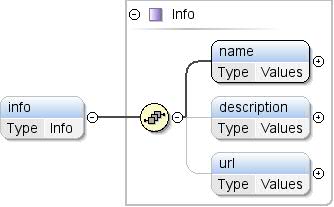组件:ConceptProperty
| 命名空间 |
http://schemas.google.com/dspl/2010 |
| 注释 |
有关概念属性的文本信息。 |
| 图示 |
 |
| 类型 |
信息 |
| 属性 |
|
| 型号 |
name、description{0,1}、url{0,1} |
| 儿童 |
description、name、url |
| 实例 |
<info>
<name>{1,1}</name>
<description>{0,1}</description>
<url>{0,1}</url>
</info>
|
| 来源 |
<xs:element name="info" type="Info" minOccurs="0">
<xs:annotation>
<xs:documentation>Textual information about the concept property.</xs:documentation>
</xs:annotation>
</xs:element>
|
| 命名空间 |
http://schemas.google.com/dspl/2010 |
| 注释 |
概念属性的数据类型。 |
| 图示 |
 |
| 属性 |
|
| 属性 |
|
| 来源 |
<xs:element name="type" minOccurs="0">
<xs:annotation>
<xs:documentation>The data type of the concept property.</xs:documentation>
</xs:annotation>
<xs:complexType>
<xs:attribute name="ref" type="DataType" use="required"/>
</xs:complexType>
</xs:element>
|
复杂类型:ConceptProperty
| 命名空间 |
http://schemas.google.com/dspl/2010 |
| 注释 |
概念的属性(例如,某个
城市)。 |
| 图示 |
 |
| 使用方数量 |
|
| 型号 |
info{0,1}、type{0,1} |
| 儿童 |
info、type |
| 属性 |
| QName |
类型 |
固定 |
默认 |
使用 |
注解 |
| 概念 |
xs:QName |
|
|
可选 |
对与值对应的概念的引用
属性。如果属性指定了 类型,则此类型
必须与所引用概念的类型相匹配。对
外部概念必须采用以下格式
“prefix:other_concept_id”,其中“前缀”为
用于外部数据集的命名空间的前缀(请参阅 XML)
命名空间)。 |
| id |
LocalId |
|
|
可选 |
概念属性的 ID。此标识符必须是
在概念内是唯一的(在所有属性和属性之间)。通过
如果指定了 concept 属性,则可以省略 id。在该部分中,
在这种情况下,系统将隐式创建一个 ID,其值为
引用的概念例如 <property
concept="geo:country"/>等同于 <property
id="country"
concept="geo:country"/> |
| isMapping |
xs:boolean |
|
false |
可选 |
如果为 true,则此属性必须引用概念,并且
此属性表示
概念和引用的概念。引用的
最多仅有一个实例引用此概念,
概念。 |
| isParent |
xs:boolean |
|
false |
可选 |
如果为 true,则此属性必须引用概念,并且
这一属性表示二者之间的层级关系,
概念和所引用的概念(例如
国家/地区)。 |
|
| 来源 |
<xs:complexType name="ConceptProperty">
<xs:annotation>
<xs:documentation>A property of a concept (e.g., the country of a city).</xs:documentation>
</xs:annotation>
<xs:sequence>
<xs:element name="info" type="Info" minOccurs="0">
<xs:annotation>
<xs:documentation>Textual information about the concept property.</xs:documentation>
</xs:annotation>
</xs:element>
<xs:element name="type" minOccurs="0">
<xs:annotation>
<xs:documentation>The data type of the concept property.</xs:documentation>
</xs:annotation>
<xs:complexType>
<xs:attribute name="ref" type="DataType" use="required"/>
</xs:complexType>
</xs:element>
</xs:sequence>
<xs:attribute name="id" type="LocalId" use="optional">
<xs:annotation>
<xs:documentation>The id of the concept property. This identifier must be unique within the concept
(across attributes and properties).
The id may be omitted if the concept property is specified. In that case, an id is
implicitly created with value the local name of the referenced concept. For instance
<property concept="geo:country"/>
is equivalent to
<property id="country" concept="geo:country"/></xs:documentation>
</xs:annotation>
</xs:attribute>
<xs:attribute name="concept" type="xs:QName" use="optional">
<xs:annotation>
<xs:documentation>A reference to a concept that corresponds to the values of the property.
If the property specifies a type, then the type must match the type of the
referenced concept.
A reference to an external concept must be of the form "prefix:other_concept_id",
where "prefix" is the prefix used for the namespace of the external dataset
(see XML namespaces).</xs:documentation>
</xs:annotation>
</xs:attribute>
<xs:attribute name="isParent" type="xs:boolean" use="optional" default="false">
<xs:annotation>
<xs:documentation>If true, then this property must reference a
concept, and this property denotes a hierarchical
relationship between this concept and the referenced
concept (e.g., the continent of a country).</xs:documentation>
</xs:annotation>
</xs:attribute>
<xs:attribute name="isMapping" type="xs:boolean" use="optional" default="false">
<xs:annotation>
<xs:documentation>If true, then this property must reference a
concept, and this property denotes a mapping
(1-to-1) relationship between this concept and the
referenced concept. Each instance of the referenced
concept is referenced by at most one instance of
this concept.</xs:documentation>
</xs:annotation>
</xs:attribute>
</xs:complexType>
|
| 命名空间 |
没有命名空间 |
| 类型 |
DataType |
| 属性 |
|
| 分面 |
| 枚举 |
字符串 |
|
| 枚举 |
float |
|
| 枚举 |
integer |
|
| 枚举 |
布尔值 |
|
| 枚举 |
date |
|
| 枚举 |
concept |
|
|
| 使用方数量 |
|
| 来源 |
<xs:attribute name="ref" type="DataType" use="required"/>
|
| 命名空间 |
没有命名空间 |
| 注释 |
概念属性的 ID。此标识符必须是唯一的
(跨属性和属性)。ID 可以是
如果指定了概念属性,则省略此参数。在这种情况下,ID 就是
使用引用概念的本地名称值隐式创建。
例如 <property concept="geo:country"/>为
等同于 <property id="country"
concept="geo:country"/> |
| 类型 |
LocalId |
| 属性 |
|
| 分面 |
|
| 使用方数量 |
|
| 来源 |
<xs:attribute name="id" type="LocalId" use="optional">
<xs:annotation>
<xs:documentation>The id of the concept property. This identifier must be unique within the concept
(across attributes and properties).
The id may be omitted if the concept property is specified. In that case, an id is
implicitly created with value the local name of the referenced concept. For instance
<property concept="geo:country"/>
is equivalent to
<property id="country" concept="geo:country"/></xs:documentation>
</xs:annotation>
</xs:attribute>
|
| 命名空间 |
没有命名空间 |
| 注释 |
对与
属性。如果该属性指定类型,则该类型必须与
所引用概念的类型。对外部概念的引用必须
其格式为“prefix:other_concept_id”,其中
"前缀"是外部命名空间的命名空间的前缀,
数据集(请参阅 XML 命名空间)。 |
| 类型 |
xs:QName |
| 属性 |
|
| 使用方数量 |
|
| 来源 |
<xs:attribute name="concept" type="xs:QName" use="optional">
<xs:annotation>
<xs:documentation>A reference to a concept that corresponds to the values of the property.
If the property specifies a type, then the type must match the type of the
referenced concept.
A reference to an external concept must be of the form "prefix:other_concept_id",
where "prefix" is the prefix used for the namespace of the external dataset
(see XML namespaces).</xs:documentation>
</xs:annotation>
</xs:attribute>
|
| 命名空间 |
没有命名空间 |
| 注释 |
如果为 true,则此属性必须引用一个概念,并且此
属性表示这一概念和
引用的概念(例如某个国家/地区的大洲)。 |
| 类型 |
xs:boolean |
| 属性 |
| 而应使用以下命令: |
可选 |
| default: |
false |
|
| 使用方数量 |
|
| 来源 |
<xs:attribute name="isParent" type="xs:boolean" use="optional" default="false">
<xs:annotation>
<xs:documentation>If true, then this property must reference a
concept, and this property denotes a hierarchical
relationship between this concept and the referenced
concept (e.g., the continent of a country).</xs:documentation>
</xs:annotation>
</xs:attribute>
|
| 命名空间 |
没有命名空间 |
| 注释 |
如果为 true,则此属性必须引用一个概念,并且此
属性表示此概念和
所引用的概念所引用概念的每个实例都是
最多被该概念的一个实例引用。 |
| 类型 |
xs:boolean |
| 属性 |
| 而应使用以下命令: |
可选 |
| default: |
false |
|
| 使用方数量 |
|
| 来源 |
<xs:attribute name="isMapping" type="xs:boolean" use="optional" default="false">
<xs:annotation>
<xs:documentation>If true, then this property must reference a
concept, and this property denotes a mapping
(1-to-1) relationship between this concept and the
referenced concept. Each instance of the referenced
concept is referenced by at most one instance of
this concept.</xs:documentation>
</xs:annotation>
</xs:attribute>
|
使用
oXygen XML Editor。
如未另行说明,那么本页面中的内容已根据知识共享署名 4.0 许可获得了许可,并且代码示例已根据 Apache 2.0 许可获得了许可。有关详情,请参阅 Google 开发者网站政策。Java 是 Oracle 和/或其关联公司的注册商标。
最后更新时间 (UTC):2024-09-09。
[null,null,["最后更新时间 (UTC):2024-09-09。"],[],[]]



